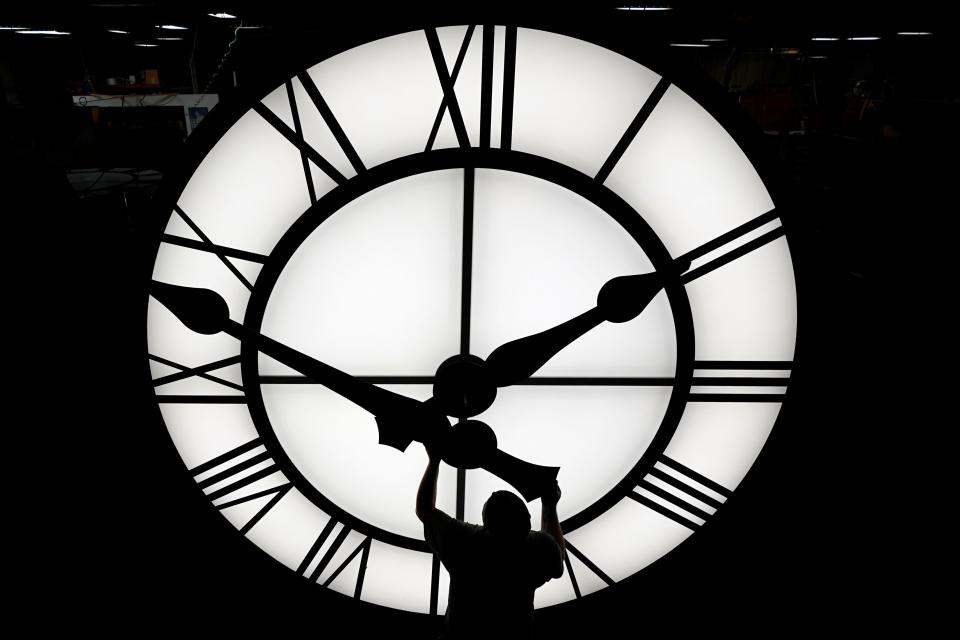Get ready to spring forward: Here's when daylight saving time 2023 begins
- Oops!Something went wrong.Please try again later.
Daylight saving time will return at 2 a.m. Sunday when clocks will spring forward one hour and we'll lose that hour of sleep.
The good news: The sun will set an hour later for the first time since October.
But why do we bother adjusting clocks and circadian rhythms twice a year?
With the impending start of spring, here's a brief explainer on what daylight saving time is, how it started, and the effort by some states to make it permanent. In fact, many states − including Massachusetts, New Hampshire and Vermont − have introduced legislation to abolish the semiannual switch.
How did daylight saving time start?
The Uniform Time Act established nationwide standards for the observance of daylight saving time when it was signed into law in 1966.
Previously, daylight saving time in the United States was not regulated by the federal government, leaving municipalities and states to decide whether to observe the practice and, if so, when it started and ended.

It was a haphazard approach. The Robert C. Byrd Center for Congressional History and Education said it left "transportation industries, including railroads, trucking and airlines with complex and constantly shifting time schedules."
And by the mid-20th century, the emerging television industry was finding it difficult to work within patchwork time zones and standards.
According to the U.S. Department of Transportation, matching clocks with available daylight − with more in the evening during the summer and vice versa in the winter − saves energy, prevents traffic injuries and reduces crime.
Who came up with daylight saving time?
The idea, at least according to Encyclopedia Britannica, was first suggested in an essay by Benjamin Franklin in 1784.
The first true proponent of daylight saving time, however, was an English builder named William Willett. In 1907, he published a pamphlet called "The Waste of Daylight" that campaigned for advancing clocks in spring and turning them back in fall, according to the National Museum of Scotland.
Moving clocks forward one hour during part of the year would provide more daylight hours after work for the training of the army, increase railway efficiency and reduce lighting expenses, among other benefits, Willett wrote.
Willett also encouraged people to get out of bed earlier in the summer to make the most of daylight. Many people probably won't remember Willett fondly because of that, but he didn't seem to care.
"Everyone appreciates the long light evenings," Willett wrote in the pamphlet. "Everyone laments their shrinkage as autumn approaches, and nearly everyone has given utterance to a regret that the clear bright light of early morning during spring and summer months, is so seldom seen or used. Nevertheless standard time remains so fixed, that for nearly half the year the sun shines upon the land, for several hours each day while we are asleep."
Should the U.S. end daylight saving time?
Recent polls have found that only 35% of Americans support resetting their clocks every fall and spring, while 59% want to see daylight saving time made permanent. And that sentiment appears to have translated to legislative action.
In the past five years, 19 states have enacted legislation or passed resolutions to provide for year-round daylight saving time, if Congress were to allow such a change and, in some cases, if surrounding states enact the same legislation, according to the National Conference of State Legislatures.
The U.S. Senate passed a bill last March that would have made daylight saving time permanent across the U.S. beginning this year. But the House of Representatives didn't take up the bill, which is called the Sunshine Protection Act.
Under the Uniform Time Act, states and territories have the authority to opt out of daylight saving time and switch to standard time, which Arizona, Hawaii, Guam, American Samoa, Puerto Rico and the U.S. Virgin Islands have done.
This article originally appeared on USA TODAY NETWORK: Get ready to spring forward: Daylight saving time returns March 12

